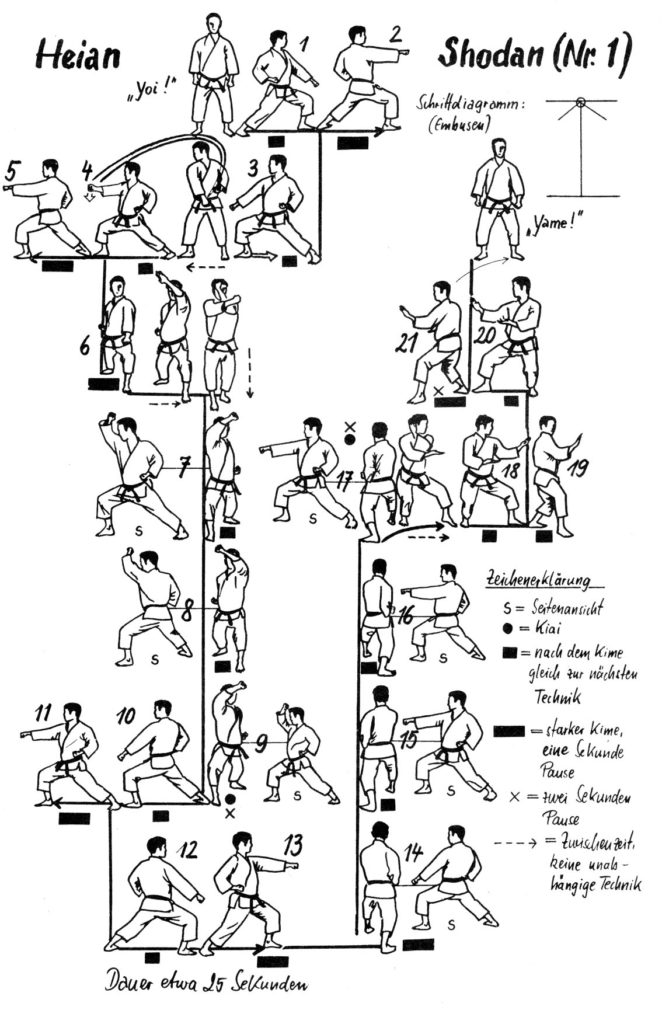Heian Shodan is the first Kata in the Heian series and is usually the first Kata that a beginner must learn. It has 21 movements and its embusen is roughly I-shaped.
This Kata takes the student through a similar floor pattern as Taikyoku Shodan, but incorporates different techniques including a hammer fist and a knife hand block. The Kata also introduces changing stances from the normal front stance into a cat stance, and later into a back stance.
HEIAN SHODAN
Peaceful Mind - first level
HEIAN SHODAN
Peaceful Mind - first level
Kata performed by Aragaki Misako
Some of the Key Moves:
- Gedan-barei (down block)
- Oi-tsuki (step-in punch)
- Age-uke (rising block)
- Shuto-uke (knife-hand block)
- Zenkutsu-dachi (front stance)
- Kokutsu-dachi (back stance)
The word Heian is a combination of Heiwan that means "Peacefulness" and Antei that means "Calmness." For this reason the meaning of the Kata signifies a "Peaceful Mind." The name suggests that the student who has mastered the five Heian forms can be confident in his ability to defend himself, and hence would be able to adopt a state of "Peaceful Mind." The original versions of the Katas were named Pinan and were created by Master Itosu in the early 1900’s. Master Funakoshi, during the creation of the Shōtōkan style, changed the names of the Katas for reasons he explains in his book Karate-Do Kyohan:
The names of the kata have come down to us by word of mouth. Names in use in the past included Pinan, Seishan, Naifanchi, Wanshu, Chinto, and the like, many of which had ambiguous meanings and have led to frequent mistakes in instruction. Since karate is a Japanese martial art, there is no apparent reason for retaining these unfamiliar and in some cases unclear names of Chinese origin simply because of earlier usage. I have therefore changed those names I considered to be unsuitable after considering the figurative nature of the old masters’ descriptions of the Kata and my own study of them.
As mentioned above, there are five Heian Katas in all; Shodan, Nidan, Sandan, Yondan, and Godan. Shodan being the simplest and Godan the most complex.
The Kata Heian Nidan was originally the first of the series but Master Funakoshi, realising that this Kata was much harder then Heian Shodan, changed the order in which they are taught "after consideration of their various points of difficulty and ease of teaching."
HEIAN SHODAN
The Kata in Practice
HEIAN SHODAN
The Kata in Practice
Greet slowly in musubi-dachi position .
Advertise the kata: "Heian Shodan".
Yoi : In position hachiji-dachi , fists closed in front of the hips.
1 - Hidari gedan-barai : Turn the head to the left and move left foot to the left in azenkutsu-dachi position , while doing a low blocking of the left arm ( gedan-barai ) and right hikit. The body pivots on the support foot (right), the hips rotate, the bust is ¾ face.
2 - Migi chudan oï-zuki: Advance the right foot on the same axis in a zenkutsu-dachiposition, while giving a right punch ( oï-zuki ) at the plexus level, left fist brought back in hikité.

3 - Migi gedan-barai: Swivel on the left leg 180 ° backwards looking over the right shoulder, arm fists in this direction and perform a low swept blocking ( gedan-barai ) of the right arm in zenkutsu-dachi , left fist in hikeness.
4 - Migi tettsui-mawashi-uchi: Bring the right foot back, in the position renoji-dachi. At the same time, pull the right wrist back and strike forward vertically with a hammer (tettsui-uchi ). The bust remains ¾ face, the left fist remains in hikité.
5 - Hidari chudan oï-zuki: Immediately chase with a direct blow of the plexus fist ( oï-zuki ) by advancing the left foot in a zenkutsu-dachi position . The punch must arrive at the same time as the foot touches the ground.
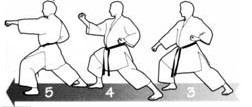
6 - Hidari gedan-barai: Pivot on the right foot by bringing the left foot 90 ° to the left in the central axis of the kata, inzenkutsu-dachi position . At the same time, firmly block down the left arm ( gedan-barai ). Bust 3/4 face, right fist in hikité. Thenon the spot, raise the left arm in blocking and open the hand.
7- Migi jodan age-uke : Perform a high level upward blockage by raising the right arm ( jodan age-uke ), open left hand in protection in front of the forehead, while advancing the right foot inzenkutsu-dachi position. The two arms cross in front of the jaw.The bust is 3/4 face, the left fist is brought back in hikeness.
8 - Hidari jodan age-uke : Open the right hand, advance the left foot in zenkutsu-dachi, realizing a blocking upward left level high ( jodan age-uke ). The two arms cross in front of the jaw. The bust is 3/4 face, the right fist is brought back in hikeness.
9 - Migi jodan age-uke : Open the left hand, advance the right foot in zenkutsu-dachi , realizing a right ascending right lock (jodan age-uke ). The two arms cross in front of the jaw. The bust is 3/4 face, the right fist is brought back in hikeness.
KIAÏ !!!

10 - Hidari gedan-barai: Pivot on the right foot by bringing the left foot 90 ° to the left, in zenkutsu-dachi position . At the same time, firmly block down the left arm ( gedan-barai). Bust 3/4 face, right fist in hikité.
11 - Migi chudan oï-zuki: Advance the right foot on the same axis in a zenkutsu-dachiposition, while giving a right punch at the level plexus ( oï-zuki ), left fist brought back in hikité.
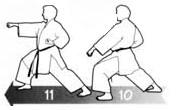
12 - Migi gedan-barai: Look backward, turn left leg 180 ° backwards looking over right shoulder, arm well with fists in this direction in preparation for blocking, blocking swept lower right arm ( gedan-barai ) in zenkutsu-dachi , left fist in hikite.
13 - Hidari chudan oï-zuki: Immediately chase with a direct blow of the plexus fist ( oï-zuki ) by advancing the left foot in a zenkutsu-dachi position. The punch must arrive at the same time as the foot touches the ground.
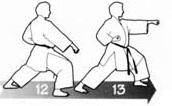
14 - Hidari gedan-barai: Pivot on the right foot by bringing the left foot 90 ° to the left in the central axis of the kata, inzenkutsu-dachi position . At the same time, firmly block down the left arm ( gedan-barai ). Bust 3/4 face, right fist in hikité.
15 - Migi chudan oï-zuki: Advance the right foot on the same axis in a zenkutsu-dachi position, while giving a right punch ( oï-zuki) at the plexus level, left fist brought back in hikité.
16 - Hidari chudan oï-zuki: Immediately chase with a direct blow of the fist ( oï-zuki ) to the plexus by advancing the left foot in a zenkutsu-dachi position . The punch must arrive at the same time as the foot touches the ground.
17 - Migi chudan oï-zuki: Advance the right foot on the same axis in a zenkutsu-dachi position, while giving a right punch ( oï-zuki) at the plexus level, left fist brought back in hikité. Follow each other faster after the 2nd punch.
KIAÏ !!!

18 - Hidari chudan shuto-uke: Pivot on the right foot by bringing the left foot 90 ° to the left, back position kokutsu-dachi. At the same time, arm the left hand open to the right ear, right arm extended open hand down. Block with the sword of the left hand level medium (shuto-uke ). Bust of 3/4 face, right hand protection plexus level.
19 - Migi chudan shuto-uke: Pivot on the left foot by bringing the right foot 45 ° to the right, back kokutsu-dachi position . At the same time, arm the right hand open to the left ear, left arm extended open hand down. Block with the sword of the right hand middle level ( shuto-uke ). Bust 3/4 face, left hand in plexus level protection.
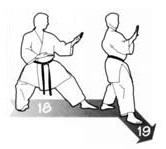
20 - Migi chudan shuto-uke: Swivel on the left foot by bringing the right foot 45 ° from the previous axis to the right, in the back position kokutsu-dachi . At the same time, arm the right hand open to the left ear, left arm extended open hand down. Block with the sword of the right hand middle level ( shuto-uke ). Bust 3/4 face, left hand in plexus level protection.
21 - Hidari chudan shuto-uke: Pivot on the right foot by bringing the left foot 45 ° to the left, back position kokutsu-dachi . At the same time, arm the left hand open to the right ear, right arm extended open hand down. Block with the sword of the left hand level medium ( shuto-uke ). Bust of 3/4 face, right hand protection plexus level.
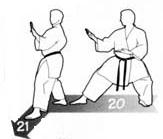
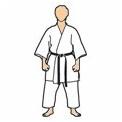
Yame in position hachiji-dachi.

